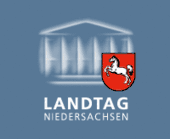Landtag of Lower Saxony
The Lower Saxon Landtag (Niedersächsischer Landtag) or the Parliament of Lower Saxony is the state diet of the German state of Lower Saxony. It convenes in Hanover and currently consists of 137 members consisting of five parties. Since 2017 the majority has been a coalition of the Social Democratic Party and the Christian Democratic Union, supporting the cabinet of Minister-President Stephan Weil (SPD).[1]
Landtag of Lower Saxony Niedersächsischer Landtag | |
|---|---|
 | |
| Type | |
| Type | |
| Established | 1947 |
| Leadership | |
President of the Landtag | Gabriele Andretta, (SPD) |
| Structure | |
| Seats | 137 |
 | |
Political groups | Government (105)
Opposition (32)
|
| Elections | |
Last election | 15 October 2017 |
| Meeting place | |
 | |
| Leineschloss, Hanover | |
| Website | |
Landtag building

The Landtag is situated in the Leineschloss, a former residence of the kings of Hanover. After its destruction in World War II it was rebuilt from 1957 to 1962. Thus, from 1947 to 1962, the parliament of Lower Saxony convened in the Old town hall (Stadthalle Hanover).
Current composition
After the elections of January 20, 2013, the composition of the Lower Saxony Landtag is as follows:
| Party | Seats | (Percent) |
|---|---|---|
| Christian Democratic Union (CDU) | 54 | 36.0% |
| Social Democratic Party (SPD) | 49 | 32.6% |
| Alliance '90/The Greens (Die Grünen) | 20 | 13.7% |
| Free Democratic Party (FDP) | 14 | 9.9% |
Elections are conducted using a proportional representation system, with a minimum of 5% vote share to receive any seats in the Landtag.
Currently, the Social Democratic Party and the Greens have a Government even though they do not have a majority of seats. This is due to Elke Twesten switching party allegiance from the Greens to the CDU on August 7, 2017, leaving the government with 68 seats and the opposition with 69 seats. Because of this, Stephan Weil, the SPD prime minister of the state, called for parliament to be dissolved and new elections to be held three months earlier than previously scheduled.[2]
Presidents of the Landtag
So far, the presidents of the Landtag of Lower Saxony have been:
- 1946–1955 Karl Olfers, Social Democratic Party (SPD)
- 1955–1957 Werner Hofmeister, German Party (DP)/Christian Democratic Union (CDU)
- 1957–1959 Paul Oskar Schuster, German Party (DP)/Christian Democratic Union (CDU)
- 1959–1963 Karl Olfers, Social Democratic Party (SPD)
- 1963–1967 Richard Lehners, Social Democratic Party (SPD)
- 1967–1974 Wilhelm Baumgarten, Social Democratic Party (SPD)
- 1974–1982 Heinz Müller, Christian Democratic Union (CDU)
- 1982–1985 Bruno Brandes, Christian Democratic Union (CDU)
- 1985–1990 Edzard Blanke, Christian Democratic Union (CDU)
- 1990–1998 Horst Milde, Social Democratic Party (SPD)
- 1998–2003 Rolf Wernstedt, Social Democratic Party (SPD)
- 2003–2008 Jürgen Gansäuer, Christian Democratic Union (CDU)
- 2008–2013 Hermann Dinkla, Christian Democratic Union (CDU)
- 2013–2017 Bernd Busemann, Christian Democratic Union (CDU)
- 2017– Gabriele Andretta, Social Democratic Party (SPD)
See also
References
External links
| Wikimedia Commons has media related to Niedersächsischer Landtag. |